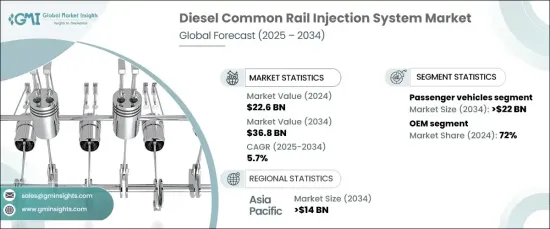
세계의 디젤 커먼 레일 분사 시스템 시장은 2024년 226억 달러로 평가되었고 2025년부터 2034년까지 연평균 복합 성장률(CAGR) 5.7%로 강력한 성장이 전망되고 있습니다. 이 성장은 주로 질소 산화물(NOx) 및 미립자 물질과 같은 유해한 오염물질을 줄이기 위해 설계된 점점 더 엄격한 배출 규제에 의해 초래됩니다. 세계 정부가 보다 엄격한 규제를 실시하고 있기 때문에 제조업체들은 규제에 대응하기 위해 첨단 연료 분사 기술을 채택해야 합니다.

연료 효율이 높은 고성능 디젤 엔진에 대한 수요가 증가함에 따라 시장 확대가 더욱 가속화되고 있습니다. 디젤 커먼 레일 분사 시스템은 연료 공급을 강화하고, 연소 효율을 최적화하며, 배출 가스를 줄임으로써 진화하는 규제 프레임워크에 완벽하게 적응합니다. 결과적으로 이러한 시스템은 최신 디젤 엔진에 필수적이며 엄격한 표준 준수뿐만 아니라 엔진 출력 및 효율 향상도 실현합니다.
| 시장 범위 | |
|---|---|
| 시작 연도 | 2024년 |
| 예측 연도 | 2025-2034년 |
| 시작 금액 | 226억 달러 |
| 예측 금액 | 368억 달러 |
| CAGR | 5.7% |
시장은 승용차와 상용차의 두 가지 주요 범주로 나뉩니다. 현재는 승용차가 주류이며 2024년에는 60%의 점유율을 차지했고 2034년에는 220억 달러에 이를 것으로 예상됩니다. 특히 장거리 이동과 뛰어난 연비 효율을 위해 디젤 엔진이 선호되는 지역에서 널리 보급되고 있는 것이 이 장점을 뒷받침하고 있습니다.
시장의 판매 채널에는 OEM(대상 브랜드 제조)과 애프터마켓의 두 부문이 있습니다. OEM은 자동차 제조업체와의 긴밀한 협력 관계를 통해 선진적인 분사 시스템을 신차에 직접 통합하는 혜택을 누리고 있으며, 2024년 점유율은 72%로 시장을 선도했습니다. 엄격한 배기 가스 규정 준수를 우선시하고 엔진 성능 향상에 주력함으로써 OEM은 저연비 기술 혁신의 최전선에 있습니다.
아시아태평양에서는 디젤 커먼 레일 분사 시스템 시장이 2024년 세계 점유율의 35%를 차지하고 2034년에는 140억 달러에 이를 것으로 예측됩니다. 이 성장의 원동력이 되고 있는 것은 급속한 공업화, 활황을 나타내는 자동차 제조 부문, 상용차 수요 증가입니다. 이 지역의 제조업체는 엄격한 환경 규제를 충족하기 위해 첨단 분사 시스템의 채택을 늘리고 있으며 추가 기술 혁신과 보급을 촉진하고 있습니다.
디젤 커먼 레일 분사 시스템 시장은 규제 압력과 연비 요구가 계속 증가하고 있기 때문에 향후 몇 년 동안 안정적인 성장이 예상됩니다. 보다 깨끗한 기술에 대한 지속적인 투자와 자동차 배출 가스 감축에 대한 세계의 뒷받침은 디젤 분사 시스템의 추가 발전을 촉진할 것으로 보입니다. 승용차와 상용차의 두 부문에서 왕성한 수요가 있기 때문에 시장은 2034년 이후에도 대폭적인 확대가 예상됩니다.
The Global Diesel Common Rail Injection System Market, valued at USD 22.6 billion in 2024, is expected to experience robust growth at a CAGR of 5.7% from 2025 to 2034. This growth is primarily driven by increasingly stringent emission regulations designed to reduce harmful pollutants like nitrogen oxides (NOx) and particulate matter. Governments across the globe are enforcing stricter standards, urging manufacturers to adopt advanced fuel injection technologies to meet compliance.

The rising demand for fuel-efficient, high-performance diesel engines further accelerates market expansion. Diesel common rail injection systems enhance fuel delivery, optimize combustion efficiency, and reduce emissions, aligning perfectly with evolving regulatory frameworks. As a result, these systems have become essential in modern diesel engines, ensuring not only compliance with stringent standards but also improved engine power and efficiency.
| Market Scope | |
|---|---|
| Start Year | 2024 |
| Forecast Year | 2025-2034 |
| Start Value | $22.6 Billion |
| Forecast Value | $36.8 Billion |
| CAGR | 5.7% |
The market is divided into two key categories: passenger vehicles and commercial vehicles. Passenger vehicles currently dominate, holding a 60% share in 2024, and are expected to reach USD 22 billion by 2034. Their widespread adoption, particularly in regions where diesel engines are favored for long-distance travel and superior fuel efficiency, fuels this dominance.
Sales channels in the market include both OEM (Original Equipment Manufacturer) and aftermarket segments. OEMs led the market with a 72% share in 2024, benefiting from close collaborations with automakers to integrate advanced injection systems directly into new vehicles. By prioritizing compliance with stringent emission standards and focusing on enhancing engine performance, OEMs are at the forefront of innovation in fuel-efficient technologies.
In the Asia Pacific region, the diesel common rail injection system market accounted for 35% of the global share in 2024 and is projected to reach USD 14 billion by 2034. This growth is driven by rapid industrialization, a booming automotive manufacturing sector, and increasing demand for commercial vehicles. Manufacturers in this region are increasingly adopting advanced injection systems to meet rigorous environmental regulations, fostering further innovation and widespread adoption.
The diesel common rail injection system market is poised for steady growth in the coming years as both regulatory pressures and fuel efficiency demands continue to rise. Ongoing investments in cleaner technologies, along with the global push toward reducing vehicle emissions, will drive further advancements in diesel injection systems. With strong demand across both the passenger and commercial vehicle sectors, the market is expected to experience significant expansion through 2034 and beyond.